Operation of police powers under the Terrorism Act 2000 and subsequent legislation: Arrests, outcomes, and stop and search, Great Britain, financial year ending 31 March 2016
Published 30 June 2016
Applies to England, Scotland and Wales
1. Key findings
1.1 Arrests and outcomes
There were 255 terrorism-related arrests in the year ending 31 March 2016, a decrease of 15% (46 arrests) compared with the previous year, which saw the highest number of arrests in any financial year on record. The majority of the fall was driven by reductions in arrests for domestic terrorism and those that could not be classified under a specific terrorist category. Although a fall on the previous year, the number of arrests in the year ending 31 March 2016 was still higher than most other recent years.
Despite the overall fall in the number of terrorism-related arrests:
- the only age group to see a rise in the number of arrests was under 18-year-olds, which saw a small increase from 8 arrests in the year ending 31 March 2015, to 14 in the year ending 31 March 2016
- the number of females arrested continued to rise, with 36 females arrested in the year ending 31 March 2016; this was the highest number in any financial year on record
1.2 Court proceedings
In the year ending 31 March 2016, there were 51 persons proceeded against for terrorism offences in England and Wales. Ninety-two per cent (47) of these were convicted, continuing a general upward trend in the proportion convicted seen in recent years.
1.3 Terrorist and extremist/separatist prisoners
As at 31 March 2016, there were 162 persons in custody in Great Britain for terrorism-related offences and domestic extremism/separatism. This was a decrease compared with the 192 persons in custody at the same time the previous year.
The overall fall was driven by a large reduction in the number of domestic extremist/separatist prisoners. The number of persons in custody for offences under terrorism legislation or for terrorism-related offences, continued to increase (from 122 as at 31 March 2015 to 147 as at 31 March 2016).
1.4 Other police powers under the Terrorism Act 2000
In the year ending 31 March 2016:
- the Metropolitan Police Service (MPS) carried out 541 stops and searches under section 43 (s.43) of the Terrorism Act (TACT) 2000, an increase of nearly a third on the previous year; over the same period, the number of resultant arrests more than doubled, bringing the arrest rate up to 12% (compared with 7% the previous year), continuing an upward trend seen in recent years
- the number of examinations under Schedule 7 to TACT 2000 in Great Britain fell by 18% to 26,200 examinations
2. Introduction
2.1 National Statistics status
This publication has recently been assessed by the United Kingdom Statistics Authority (UKSA) and, as a result, the UKSA designated these as National Statistics in May 2016. This means that these statistics meet the highest standards of trustworthiness, impartiality, quality and public value, and are fully compliant with the Code of Practice for Official Statistics. As part of the assessment process, the Home Office has reviewed and improved the user guide that accompanies this release. This now contains more details about the strengths and limitations of the various datasets within the publication, as well as the steps taken to engage with users. Further details on the assessment process can be found on the UKSA website.
2.2 Overview
This release covers the use of police powers under terrorism and terrorism-related legislation in Great Britain on an annual basis up to the year ending 31 March 2016. Some quarterly breakdowns are provided in the supplementary tables. The release is broken down into 4 sections.
The Arrests and outcomes section uses data provided by the National Counter Terrorism Policing Functions Command (NCTPFC) and includes statistics for Great Britain on:
- arrests for terrorism-related activity and outcomes (such as charges and convictions) following arrests
- the legislation used to bring charges and convictions
- gender, age, ethnicity, and nationality of those arrested, charged and convicted
- the type of terrorism involvement of those arrested, charged and convicted (such as whether the individual had links to international, domestic, or Northern Ireland-related terrorism)
A flow chart summarising this section can be found in Annex A.
The Court proceedings section uses data from the Crown Prosecution Service (CPS) and includes statistics for England and Wales on:
- the number of persons proceeded against by the CPS for terrorism-related activity
- the legislation under which persons have been prosecuted and convicted
- the sentence length given to those convicted for terrorism-related offences
- the outcome of appeals against convictions or sentences
The Terrorist and extremist/separatist prisoners section uses data from the National Offender Management Service (NOMS) and the Scottish Prison Service (SPS) and includes statistics for Great Britain on:
- the number of persons in custody for domestic extremism and terrorism-related offences
- the ethnicity, nationality and religion of those in custody
- the number of persons released from custody
The Other police powers under the Terrorism Act 2000 section uses data provided by the Metropolitan Police Service (MPS), the National Counter Terrorism Policing Headquarters (NCTPHQ) and the NCTPFC, and includes statistics on:
- the number of stops and searches carried out by the MPS under s.43 of the Terrorism Act (TACT) 2000
- the number of examinations and subsequent detentions made in Great Britain under Schedule 7 to TACT 2000
- data on goods examinations, strip searches and postponement of questioning refusals under Schedule 7 to TACT 2000
- the number of cordons used under s.33 of TACT 2000
The user guide provides further details on this release. It includes details on the strengths and limitations of the datasets, as well as the quality assurance processes involved in ensuring that the data meet the highest possible standard. It also includes a summary of the criminal justice process, a glossary of terms used in the publication, and more detailed information about the legislation and categories mentioned in this release.
A flow chart summarising the Arrests and outcomes section of this release can be found in Annex A.
3. Arrests and outcomes
3.1 Introduction
Statistics presented in this section represent the number of persons arrested by police in Great Britain, where there is suspicion of involvement in a terrorism-related offence, either at the time of arrest or at a subsequent point in the investigation. In some cases, evidence may emerge after a terrorism-related arrest that suggests a suspect does not have links to terrorist activity, but has committed a non-terrorism-related offence. These cases are included in the data as non-terrorism-related charges and or convictions.
Outcomes following arrests for terrorism-related offences are also included in the statistics and show the number of arrests that led to a charge or prosecution, as well as other outcomes. Demographic information about those arrested, charged and convicted is also provided in this section. All data in this section are based on the date of arrest. This allows users to see the outcomes of all of the arrests in a specific period (such as how many led to a charge and conviction).
As cases progress over time, figures are likely to change. This is particularly relevant for more recent time periods where a larger number of cases will be incomplete (‘released on bail’, or ‘awaiting prosecution’). While the effect on the arrests total should be minimal, the number of charges and convictions will be lower for more recent quarters as a greater number of cases would not have reached the point of charge or conviction yet. These quarters will be updated in future publications.
Data are provided to the Home Office by the NCTPFC and are taken from a live database. This section includes annual breakdowns of the data from 11 September 2001 (when the data collection began) to the year ending 31 March 2016. A brief summary of quarterly trends over the most recent 9 quarters is also provided. The data are correct as at the time of provision to the Home Office (18 April 2016).
A flow chart summarising this section is included in Annex A. This follows individuals from the point of arrest through to charge (or other outcome) and prosecution. Tables A.01 to A.13 include data on arrests and outcomes. Quarterly tables which breakdown the data for the most recent 9 quarters to 31 March 2016, are also provided alongside this release.
3.2 Arrests
In the year ending 31 March 2016, there were 255 arrests for terrorism-related offences in Great Britain, a fall of 15% compared with the previous year (which saw the highest number of arrests on record). Despite this fall, the number of arrests remained higher than most of the last 10 years. Since the year ending 31 March 2011, around the time of the Arab Spring, there has been a general upward trend in the number of arrests for terrorism-related offences.
A decreasing proportion of arrests for terrorism-related offences have been conducted under s.41 of TACT 2000 since the year ending 31 March 2007. This power allows the police to detain a suspect for a longer period of time than permitted under standard powers of arrest (currently a maximum of 14 days, compared with 4 days under standard powers). In the year ending 31 March 2016, less than 1 in 5 arrests for terrorism-related offences were conducted under s.41 of TACT 2000, compared with around 9 in 10 arrests 10 years ago.
Figure 3.1: Arrests for terrorism-related offences, by legislation, Great Britain
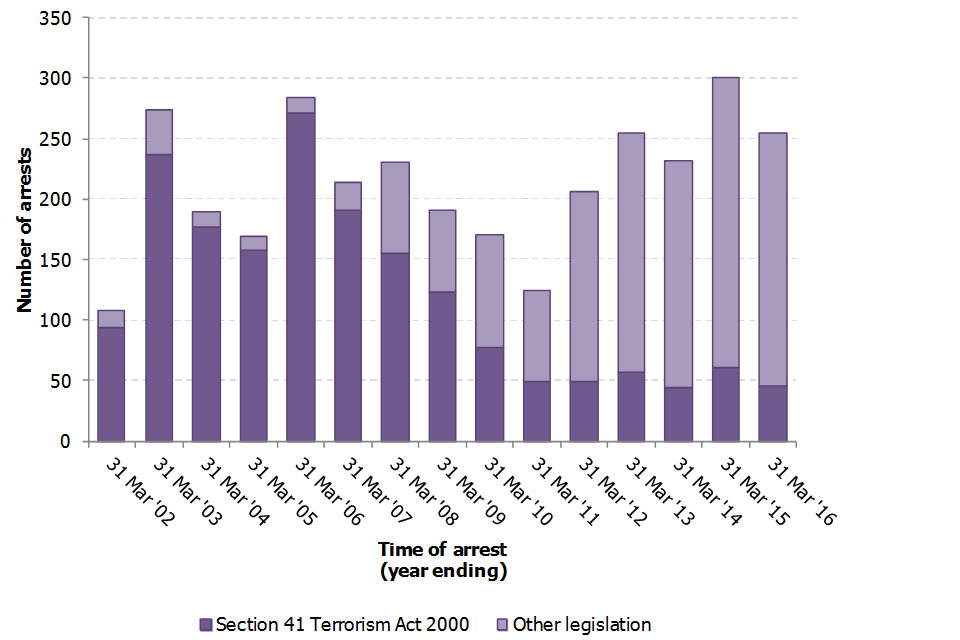
Not supplied by author.
Source: NCTPFC (see data table A.01).
Notes:
- Figures for the year ending 31 March 2002 include data from 11 September onwards only.
- ‘Other legislation’ includes arrests under non-terrorism legislation, such as the Police and Criminal Evidence Act 1984.
3.3 Pre-charge detentions under section 41 of the Terrorism Act 2000
Once a suspect has been arrested by the police, they may be held for a specified period of time before being charged. This gives police the time to investigate and accumulate evidence relating to potential terrorism offences. The current maximum period of detention under s.41 of TACT 2000 is 14 days (reduced from 28 days on 25 January 2011), compared with a maximum of 4 days under standard arrest powers. Further details of the legislation can be found in the user guide.
Forty-six persons were arrested and detained under s.41 of TACT 2000 in the year ending 31 March 2016, 15 fewer than the previous year. Of the 46 persons detained in the year ending 31 March 2016, 25 were subsequently charged, a similar number to the previous year (29).
Further details on the length and outcomes of detentions under s.41 of TACT 2000 can be found in data table A.02.
Figure 3.2: Detentions under s.41 of the Terrorism Act 2000, by outcome

Not supplied by author.
Source: NCTPFC (see table A.02).
Notes:
- Based on time of arrest.
- ‘Other outcomes’ include cautions for non-terrorism offences, transfers to immigration authorities, transfers to the Police Service for Northern Ireland, those released on bail, etc.
- Figures for the year ending 31 March 2002 include data from 11 September onwards only.
3.4 Charges
Of the 255 arrests for terrorism-related offences in the year ending 31 March 2016:
- 86 (34%) resulted in a charge
- 97 (38%) have been released without charge
- 64 (25%) persons were bailed to return
- 8 (3%) faced alternative action.
Figure 3.3: Charging outcomes following an arrest for a terrorism-related offence, year ending 31 March 2016
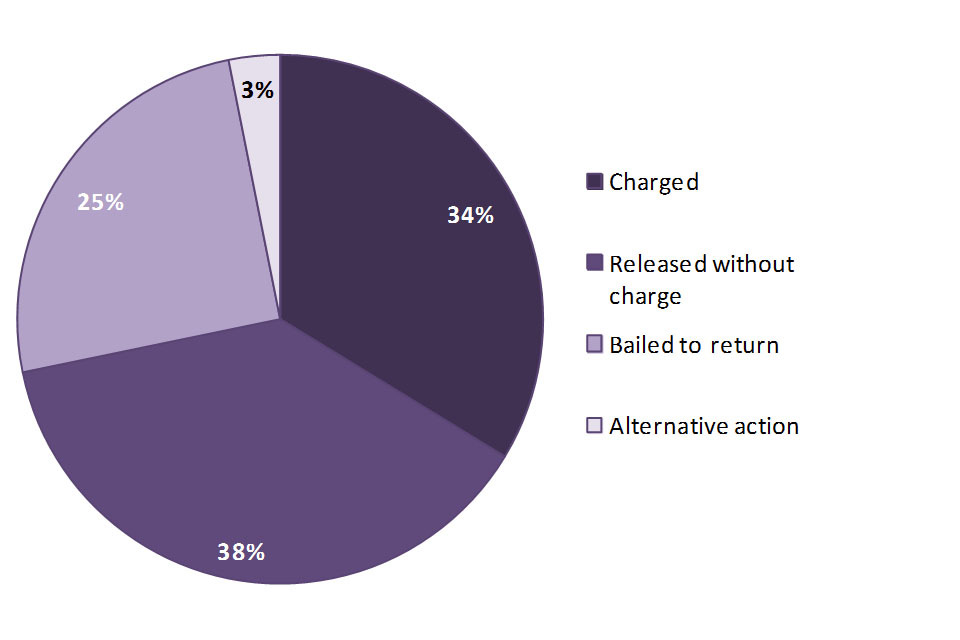
Not supplied by author.
Source: NCTPFC (see table A.03).
Notes:
- ‘Alternative action’ includes cautions for non-TACT offences, detentions under the mental health act, recall to prison, etc.
- ‘Bailed to return’ includes those release on bail pending further investigation, and those who have absconded from bail.
Of the 86 persons charged in the year ending 31 March 2016, 88% (76) have been charged with terrorism-related offences, similar to the 87% in the previous year. The proportion of charges that were terrorism-related over the most recent 2 years was higher than that seen in previous periods. Since 11 September 2001 (when the current data began to be collected), only 67% of charges have been terrorism-related. This suggests that, more recently, when the police have enough evidence to charge, they are able to substantiate links to terrorism in a greater proportion of cases.
Figure 3.4: Charges following arrests for terrorism-related offences, by type of charge, Great Britain
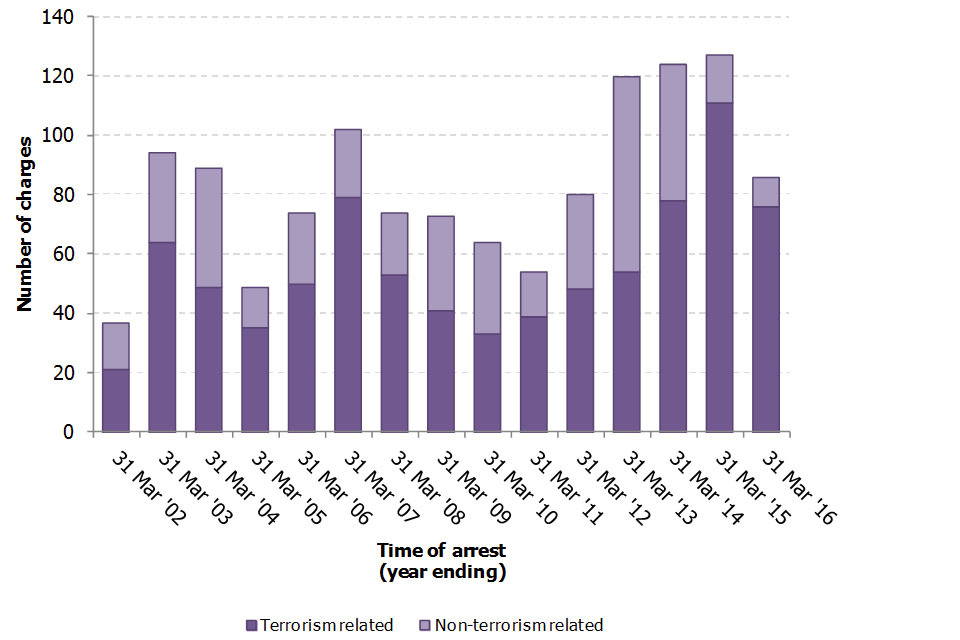
Not supplied by author.
Source: NCTPFC (see data table A.04).
Notes:
- The number of charges over time should not be compared on a like-for-like basis. More recent years will have a larger number of incomplete cases, so the number of charges is likely to change as these cases reach completion.
More recent years and or quarters are likely to have a larger proportion of cases that are incomplete (such as cases where the suspect is released on bail). This is shown in table A.03 where a large proportion of cases in the year ending 31 March 2016 have a suspect who has been released on bail (25%), compared with 2% in the previous year. As time passes, cases will progress, meaning that the number of persons released on bail will decrease, while the number of charges (and other outcomes) is likely to increase. For this reason, the charge rate in more recent years/quarters is likely to be lower than older years/quarters. Charge rates should not be compared on a like-for-like basis until all cases within the time period have been completed.
3.5 Charges by offence
In line with the normal procedures for criminal justice statistics, each suspect has been classified in terms of a single principal offence. This means that when an individual is charged with a number of offences at the same time, they are recorded only against the most serious one – usually the one that carries the highest penalty. This means that the figures count the number of individuals charged, rather than the number of individual offences committed that led to a charge.
The most common offence for which persons have been charged with under terrorism legislation since 11 September 2001 is ‘preparation for terrorist acts’ (section 5 of TACT 2006), which has accounted for 21% of all charges under terrorism legislation.
Further details of the legislation under which persons have been charged following an arrest for a terrorism-related offence can be found in tables A.05a-c.
3.6 Convictions
Of the 76 persons charged with a terrorism-related offence in the year ending 31 March 2016, 37 have been prosecuted (as at the time of data provision to the Home Office, 18 April 2016), 36 of whom have been convicted of an offence. A further 36 persons were awaiting prosecution. Figure 3.5 shows the outcomes following a charge for a terrorism-related offence.
Figure 3.5: Outcomes following a charge for a terrorism-related offence, Great Britain, year ending 31 March 2016
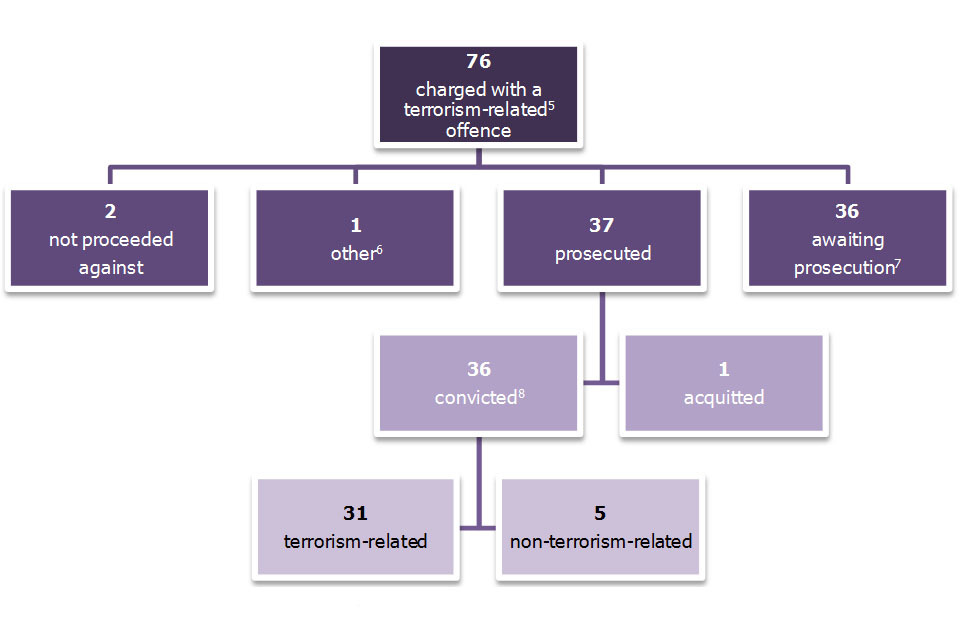
Not supplied by author.
Source: NCTPHQ (see data table A.06c).
Notes:
- Based on time of arrest.
- A more detailed flow chart can be found in Annex A.
- Data presented are based on the latest position with each case as at the date of data provision from NCTPFC (18 April 2016).
- The chart does not include outcomes following non-terrorism-related charges.
- Terrorism-related charges and convictions include some charges and convictions under non-terrorism legislation, where the offence is considered to be terrorism-related.
- The ‘other’ category includes other cases/outcomes such as cautions, transfers to UK Border Agencies, the offender being circulated as wanted, and extraditions.
- Cases that are ‘awaiting prosecution’ are not yet complete. As time passes, these cases will eventually lead to a prosecution, ‘other’ outcome, or it may be decided that the individual will not be proceeded against.
- Excludes convictions that were later quashed on appeal.
3.7 Convictions by offence
As with the data on charges, convictions data are also based on the principal offence rule. Where an individual is prosecuted for more than one offence at a time, they are classified in terms of a single offence, usually the most serious.
Since 11 September 2001, the most common offence for which persons have been convicted following a terrorism-related charge, is ‘preparation for terrorist acts’ (section 5 of TACT 2006), which has accounted for 29% of all convictions under terrorism legislation.
Further details of the legislation under which persons have been convicted following a charge for a terrorism-related offence can be found in tables A.08a-c.
3.8 Demographics of persons arrested
This section includes statistics on the number of persons arrested by different demographic characteristics as well as terrorist categorisation. It includes data on:
- gender
- age
- ethnic appearance
- nationality
- terrorist category
Gender
In the year ending 31 March 2016, 36 females were arrested for terrorism-related offences, which accounted for 14% of all arrests. This was 1 more arrest than the previous year, and has followed a steady increase in the number of females arrested since the year ending 31 March 2011 when there were only 10 females arrested (8% of all arrests). All but 2 of the females arrested in the most recent year were considered to have links to international-related terrorism.
Figure 3.6: Arrests for terrorism-related offences by sex, Great Britain
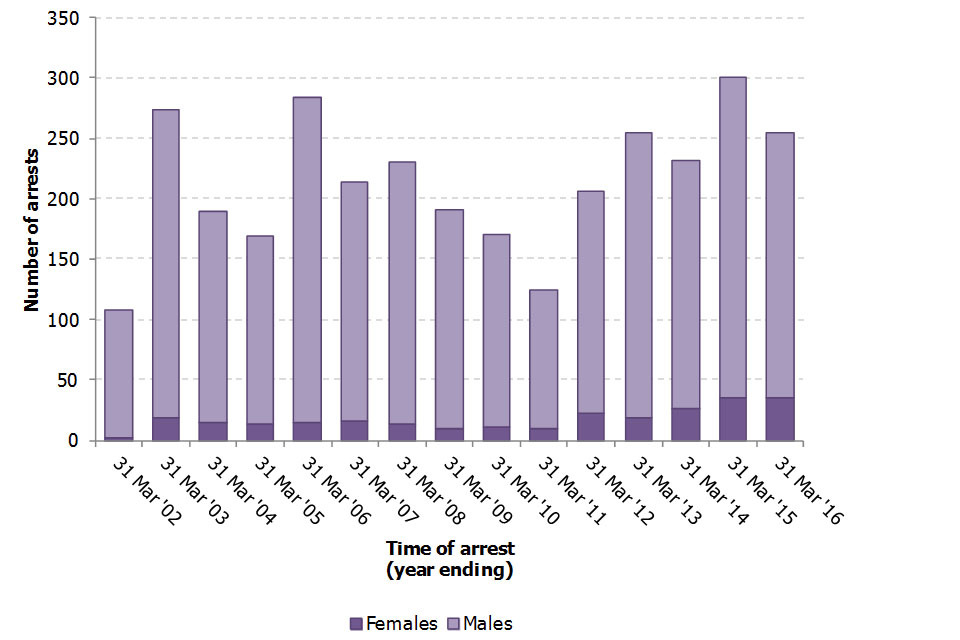
Not supplied by author.
Source: NCTPFC (see data table A.09).
Age
In the year ending 31 March 2016, 14 under 18s were arrested for terrorism-related offences. This was 6 more arrests than the previous year, and was the only age category to see an increase. Across the same period, the number of 18-20-year-olds arrested more than halved, from 44 arrests to 20. All but 1 of the under 18s arrested in the most recent year were considered to have links to international-related terrorism.
Figure 3.7: Arrests for terrorism-related offences by age group, Great Britain
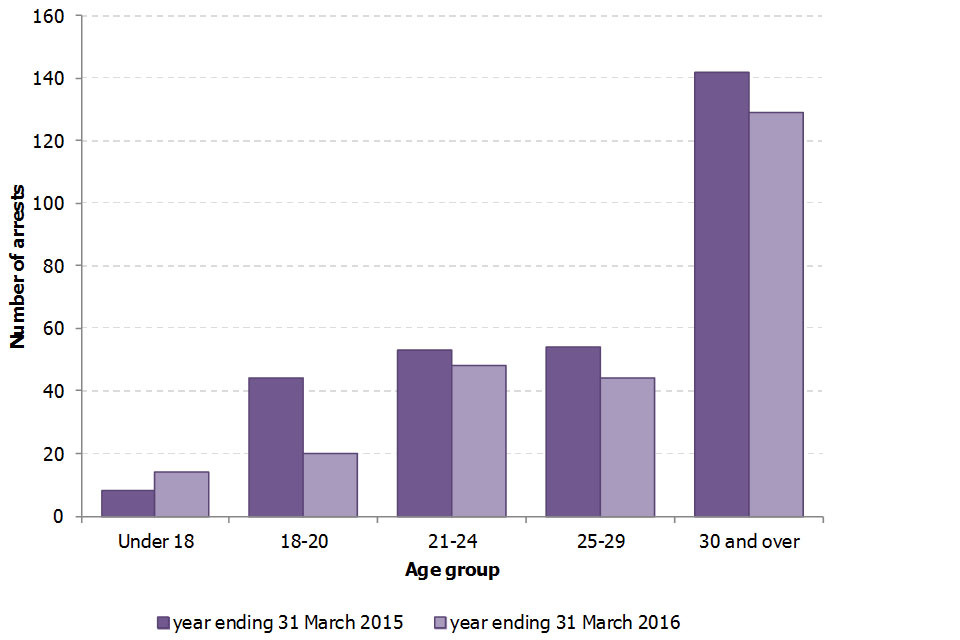
Not supplied by author.
Source: NCTPFC (see data table A.10).
Ethnic appearance
The fall in the number of arrests for terrorism-related offences was driven by a fall in arrests of people from white ethnic groups (which fell by a quarter, from 88 to 66 arrests) and black ethnic groups (which nearly halved, from 49 to 25 arrests). Arrests of those from Asian ethnic groups, which made up more than half (55%) of all arrests in the year ending 31 March 2016, remained relatively stable.
Nationality
Over three-quarters (76%) of those arrested for terrorism-related offences were of persons with British, or British dual nationality in the year ending 31 March 2016. This has increased considerably in recent years. Since 11 September 2001 (when the data collection began), only 56% of those arrested were of British, or British dual nationality.
Figure 3.8: Self-defined nationality of persons arrested for terrorism-related offences

Not supplied by author.
Source: NCTPFC (see table A.12a).
Notes:
- Excludes those who did not state their ethnicity.
Terrorist category
In the year ending 31 March 2016, the number of persons arrested for terrorism-related offences fell across all terrorist categories, with the exception of Northern Ireland-related terrorism which increased from 3 to 6. However, the number of arrests for international terrorism fell by 5 arrests, which was much smaller than the fall in arrests for domestic terrorism which fell by 22 arrests.
3.9 Quarterly trends
This section outlines trends in arrests for terrorism-related offences over the most recent 9 quarters to 31 March 2016. The wide-ranging nature of terrorism investigations that the police undertake can lead to fluctuations in the number of arrests from one quarter to the next. Furthermore, individual investigations involving multiple suspects are likely to influence the figures more than investigations involving smaller numbers of suspects.
The number of arrests for terrorism-related offences fell to 42 between January and March 2016. This was the lowest number of arrests in any of the most recent 9 quarters.
Figure 3.9: Quarterly breakdown of arrests for terrorism-related offences, Great Britain
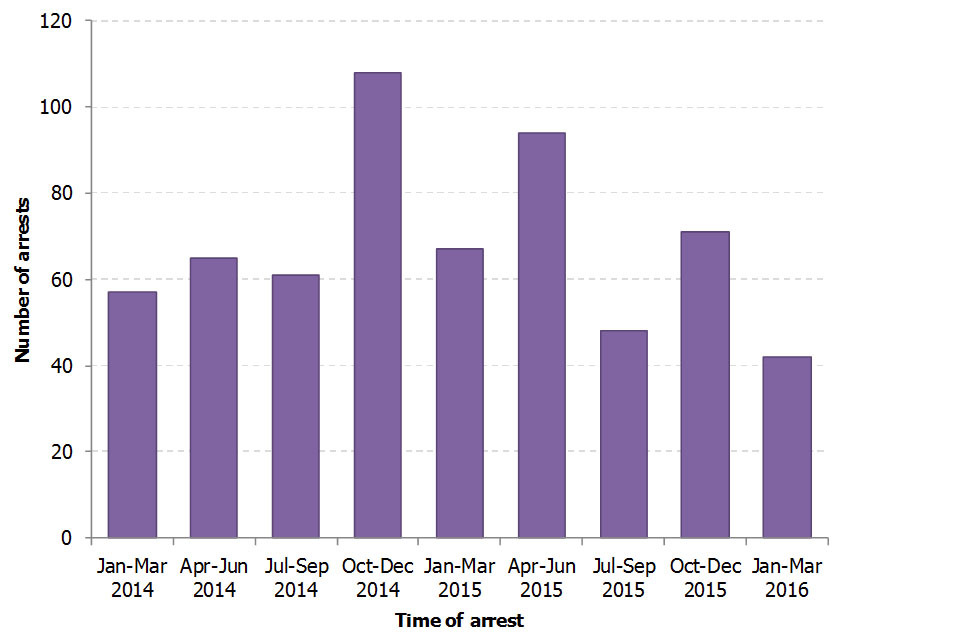
Not supplied by author.
Source: NCTPFC (see quarterly table A.01).
Further breakdowns of the quarterly trends, such as details on charges and prosecutions, as well as data on the demographics of those arrested can be found in the quarterly data tables.
3.10 Data tables
Additional data are available in the data tables which accompany this release. These include more detailed breakdowns of the data in this section. Quarterly data tables, which provide data for the most recent 9 quarters, are also included alongside this release.
4. Court proceedings
4.1 Introduction
This section presents statistics on prosecutions for terrorism-related offences in England and Wales. It provides data on the number of persons prosecuted and convicted, including information on the legislation against which they were prosecuted. It also provides information on the length of sentence that each defendant faces. Data in this section are based on the trial completion date and are not directly comparable to the prosecutions data in Section 3, Arrests and outcomes. This section also includes data on appeals against terrorism convictions and sentences.
Data are provided to the Home Office by the Crown Prosecution Service Counter Terrorism Division (CPS CTD). The data cover terrorism-related court cases that were completed in the last 7 years up to 31 March 2016.
4.2 Court proceedings
In the year ending 31 March 2016, there were 51 trials completed by the CPS CTD for terrorism-related offences. This was one fewer than the 52 trials completed in the previous year.
Of the 51 persons proceeded against, 47 (92%) were convicted. In the remaining 4 cases the defendant was acquitted. The proportion of those convicted was higher than the previous year, and has generally been increasing in recent years.
Figure 4.1: Outcome of terrorism-related trials under TACT and non-TACT legislation, year ending 31 March 2015 and year ending 31 March 2016

Not supplied by author.
Source: CPS CTD data tables C.01-C.03.
4.3 Chart Notes:
- Based on the principal offence for which the defendant was prosecuted against.
- TACT offences include offences specifically under terrorism-legislation.
- Non-TACT offences include offences under other legislation.
- Can include trials ending in a hung jury, or where the prosecution offered no evidence.
4.4 Sentencing
A total of 47 persons were convicted of terrorism-related offences in the year ending 31 March 2016. Of these, 21 pleaded guilty and 26 entered a not-guilty plea.
As with the previous years, the most common length of sentence given to persons convicted of terrorism-related offences was between one and four years. The number of people receiving a sentence between 4 and 10 years nearly doubled from 9 to 17.
Figure 4.2 Sentence length for persons convicted of terrorism-related offences, year ending 31 March 2015 and 31 March 2016
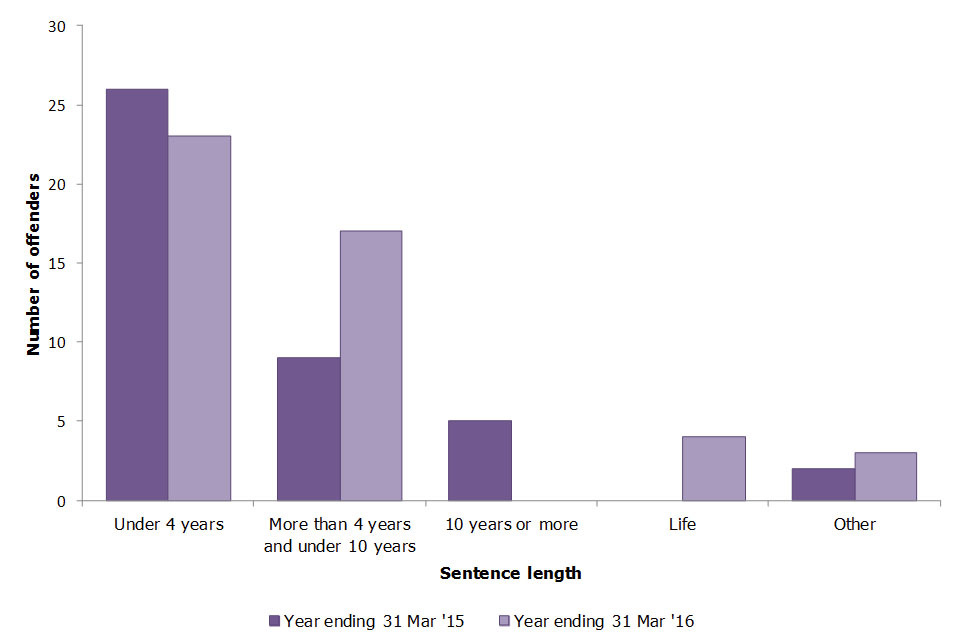
Not supplied by author.
Source: CPS CTD data tables C.04.
Chart Notes:
- Based on the trial completion date.
- The ‘other’ category includes hospital orders and non-custodial sentences.
4.5 Appeals
Over the 7 year period from 1 April 2009 to 31 March 2016, there have been a total of 57 appeals against terrorism convictions heard by the courts, of which 46 (81%) were either dismissed by the court or abandoned by appellants prior to the decision being made. No appeals resulted in convictions being quashed over the 7 years; however, 10 appeals resulted in a sentence being reduced and 1 appeal resulted in a sentence being increased.
4.6 Data tables
Additional data are available in tables C.01 to C.05 which accompany this release. These include more detailed breakdowns of the data in this section, as well as data on:
- the legislation under which persons were proceeded against table C.02
- the legislation under which persons were convicted table C.03
- the outcomes of appeals table C.05
5. Terrorist and extremist/separatist prisoners
5.1 Introduction
Statistics presented in this section give information on the number of persons in custody for terrorism-related offences and domestic extremism/separatism in Great Britain. It includes breakdowns of the ethnicity, nationality and religion of prisoners at a given time. Data on the number of terrorist and extremist/separatist prisoners released from custody are also available in this section.
Data are provided to the Home Office by NOMS and the SPS. The data give information about the prison population as at the 31 March for each of the last 7 years. Data on the number of prisoners released are also provided and cover each of the last 5 calendar years up to December 2015. Figures up to March 2016 are not yet available from NOMS. These figures will form a subset of the prison releases statistics which will be published by the Ministry of Justice in their Offender management statistics quarterly release in July 2016.
5.2 Persons in custody
As at 31 March 2016, there were 162 persons in custody in Great Britain for terrorism-related offences and domestic extremism/separatism. These included:
- 147 persons in custody for terrorism-related offences
- 15 persons in custody for domestic extremism/separatism
This was a decrease of 30 persons compared with the situation as at 31 March 2015. The fall has been driven by a large reduction in the number of domestic extremist/separatist prisoners, which has returned to the levels seen between 2010 and 2013 after two consecutive year-on-year increases. The number of persons in custody for terrorism-related offences has continued to see a steady increase.
Figure 5.1: Number of persons in custody for terrorism-related offences and domestic extremism/separatism, Great Britain
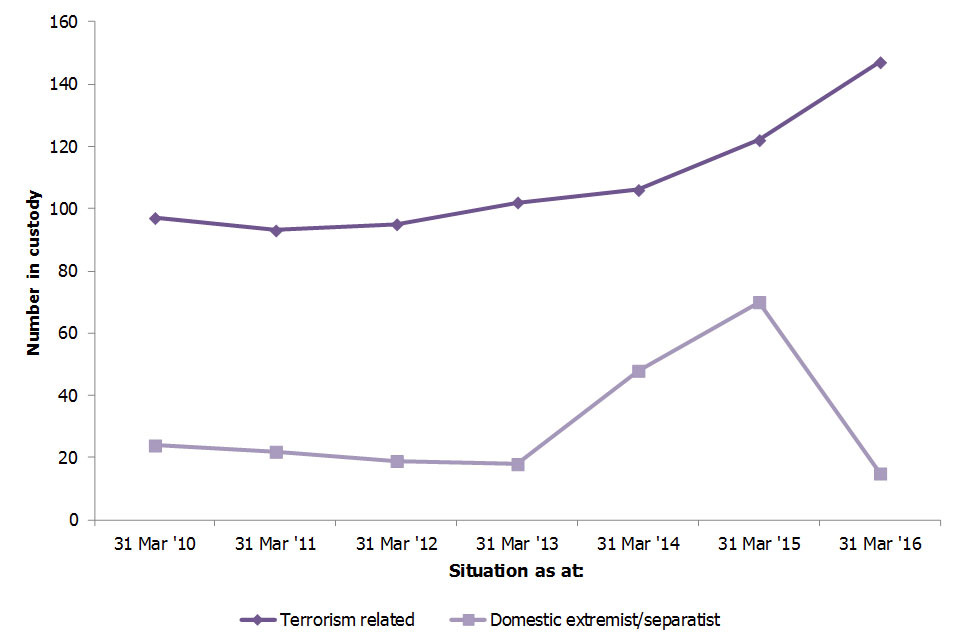
Not supplied by author.
Source: NOMS and SPS data tables P.01.
The demographic breakdown of those in custody differed between those in custody for terrorism-related offences and those in custody for domestic extremism/separatism.
As at 31 March 2016, of the 147 persons in prison for terrorism-related offences:
- 137 (93%) considered themselves to be Muslim
- 58% considered themselves to be of Asian or Asian British ethnicity (excluding cases where ethnicity was unrecorded)
- 80% considered themselves to be of British nationality (excluding cases where nationality was unrecorded)
As at 31 March 2016, of the 15 persons in prison for domestic extremism/separatism:
- 8 considered themselves to be Christian, and 6 considered themselves to have no religion
- all but one person considered themselves to be of White ethnicity
- all considered themselves to be of British nationality
5.3 Persons released from custody
A total of 128 terrorist and extremist/separatist prisoners were released from custody in Great Britain in the year ending 31 December 2015. Eighty-three of the 128 releases were persons discharged from custody after serving their sentences, many of whom will have been released subject to meeting certain licence conditions.
Of the 128 terrorist and extremist/separatist prisoners released from custody, the majority (75) had sentence lengths of less than 4 years. A further 40 were not sentenced, which includes a number of persons held on remand prior to a charge or conviction.
For more details on releases from custody, see the user guide.
5.4 Data tables
Additional data are available in tables P.01 to P.06 which accompany this release. These include more detailed breakdowns on:
- the ethnicity, nationality and religion of those in custody data tables P.02 to P.04
- the sentence lengths of those released from custody data table P.05
6. Other police powers under the Terrorism Act 2000
6.1 Introduction
This section presents statistics on the use of stop and search powers available to the police under TACT 2000. It includes data on the number of stops and searches and resultant arrests, carried out by the MPS under s43 of TACT 2000. It also includes data on the use of powers under Schedule 7 to TACT 2000 in Great Britain. This includes the number of examinations, resultant detentions, sea and air freight examinations, strip searches, and the number of times postponement of questioning was refused. Data on the use of cordons under s.33 of TACT 2000 are also presented.
Data on s.43 stop and search are provided to the Home Office by the MPS. Data on Schedule 7 are provided to the Home Office by the NCTPHQ; data on cordons are provided by NCTPFC. This section covers the use of these powers in each of the last 7 years up to 31 March 2016.
The police have the power to stop and search individuals under s.47A (previously 44) of TACT 2000. However, since the legislation was formally amended in 2011, to significantly raise the threshold for authorisation of the power, there have not been any stops and searches under this power in Great Britain. See the user guide for more details.
6.2 Stop and search under the Terrorism Act 2000
Section 43 of TACT 2000 allows a constable to stop and search a person whom he/she reasonably suspects to be involved in terrorist activity. As many forces are unable to separate s.43 TACT stops and searches from other stops and searches, this section includes data from the MPS only and excludes ‘vehicle only’ stops and searches.
In the year ending 31 March 2016, 541 persons were stopped and searched by the MPS under s.43 of TACT 2000. This represents a rise of 32% on the previous year’s total of 410. This increase was influenced by a relatively low number of searches carried out between April to June 2014 (55) in the previous period, and a particularly high number of searches between October and December 2015 (203) in the current period. Additionally, each quarter in the current period saw a higher number of stops and searches than the corresponding quarter in the previous period.
Despite the increase seen in the latest year, the number of persons stopped and searched has fallen by 56% in the year ending 31 March 2016, compared with the year ending 31 March 2010.
Up until the most recent year, the number of resultant arrests had remained steady, leading to an increase in the arrest rate. In the year ending 31 March 2016, the number of resultant arrests more than doubled compared with the previous year, leading to an arrest rate of 12% (up 6 percentage points compared with the previous year).
Details on the overall use of stop and search in England and Wales up to the year ending 31 March 2015 can be found in the Home Office Police powers and procedures, England and Wales statistical releases. The MPS also publishes monthly Stop and Search reports on the wider use of stop and search within the force.
Figure 6.1: Stops and searches and resultant arrests under s.43 of TACT 2000, MPS
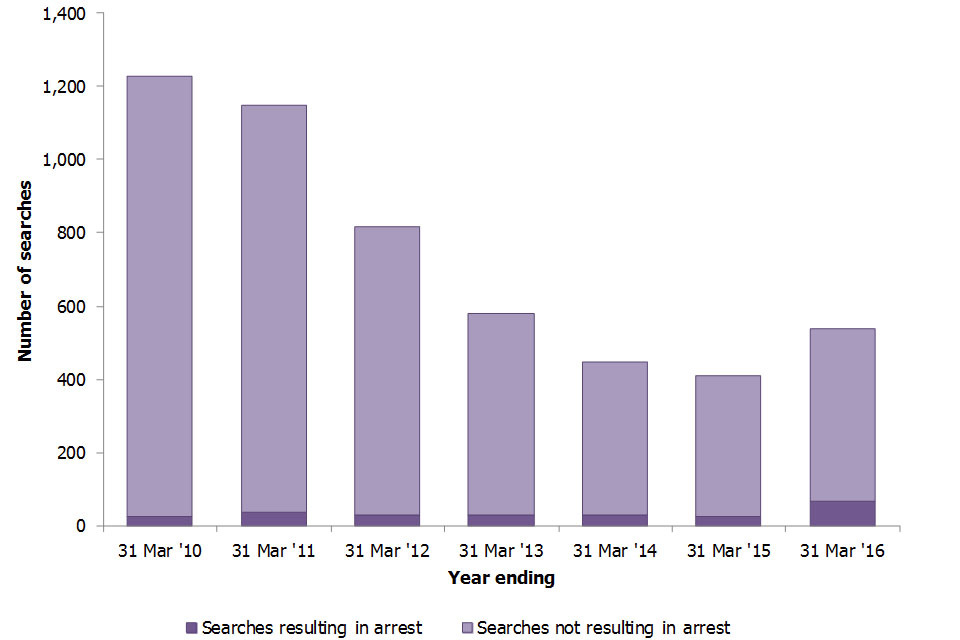
Not supplied by author.
Source: MPS data table S.01.
Chart Notes:
- Excludes ‘vehicle only’ searches.
The number of people stopped and searched under s.43 of TACT 2000 rose for every ethnicity between the years ending 31 March 2015 and 31 March 2016, except for those who self-defined as White, which saw a 9% fall.
Those who self-defined as White or Asian or Asian British were subject to the most stops and searches, accounting for 34% each of the total (excluding those who did not state their ethnicity) in the year ending 31 March 2016.
6.3 Schedule 7 to the Terrorism Act 2000
Under Schedule 7 to TACT 2000, an examining officer has several powers, the uses of which are covered in this section. These include:
- examinations of persons and resultant detentions
- goods examinations
- strip searches
- refusals to postpone questioning
Examinations and resultant detentions
An examining officer may stop and question individuals entering or leaving the country through ports, airports, international rail stations and the border area. When necessary they may also detain and search individuals. The aim is to determine whether that person appears to be someone who is or has been concerned in the commission, preparation or instigation of acts of terrorism.
In the year ending 31 March 2016, a total of 26,167 persons were examined under this power in Great Britain, a fall of 18% on the previous year.
Throughout the same period, the number of detentions following examinations increased by 39%, from 1,311 in the year ending 31 March 2015 to 1,821 in the year ending 31 March 2016. The increase in the number of detentions follows the introduction of the Anti-social Behaviour, Crime and Policing Act 2014 in August 2014, which amended the powers under Schedule 7 to TACT 2000 to ensure that a mandatory detention takes place where an examination lasts for more than an hour.
Figure 6.2: Number of Schedule 7 examinations and number which led to a subsequent detention, Great Britain
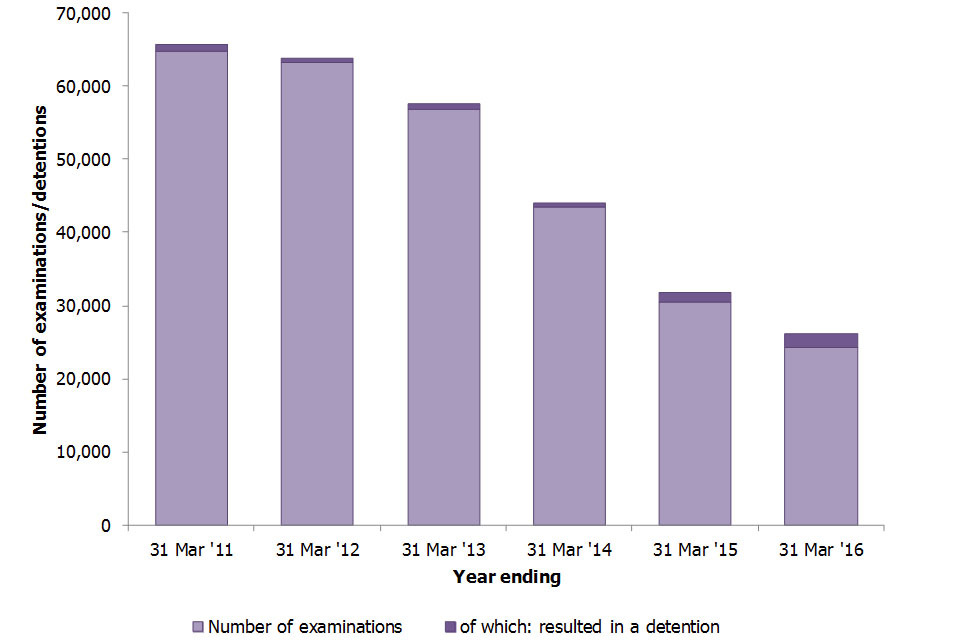
Not supplied by author.
Source: NCTPHQ data table S.03.
The fall in the number of examinations was seen across all ethnic groups, most notably White, which saw a fall of 3,245 examinations (or 31%) in the year ending 31 March 2016 compared with the previous year.
The proportion of those examined whose ethnicity was White fell by 6 percentage points in the year ending 31 March 2016 compared with the previous year. Whilst the proportion of those examined whose ethnicity was Asian or Asian British and Chinese or Other, rose by 5 and 3 percentage points respectively.
Figure 6.3: Schedule 7 examinations by ethnicity

Not supplied by author.
Source: NCTPHQ data table S.03.
Chart Notes:
- Excludes cases where ethnicity was ‘Not stated’.
- Prior to the year ending 31 March 2011, the Home Office did not collect ethnic breakdowns of persons examined or detained.
Goods examinations
The NCTPHQ has provided data to the Home Office on goods examinations since April 2015. Goods are defined non-exhaustively under paragraph 9 of Schedule 7 as “property of any description, and containers”. The Counter-Terrorism and Security Act 2015 clarified the legal position around the examination of goods in remote storage outside the immediate boundary of a port and the examination of goods comprising items of post. A goods examination under Schedule 7 may only be carried out by a trained, accredited and designated examining officer. An examining officer may only examine goods for the purpose of determining whether they have been used in the commission, preparation or instigation of acts of terrorism.
In the year ending 31 March 2016, a total of 4,139 air freight and 5,292 sea freight examinations were conducted.
Strip searches
A strip search is a search involving the removal of more than outer clothing. Strip searches do not extend to requiring a person to undergo an intimate search (searching a person’s body orifices other than the mouth). A strip search may only take place where an examining officer has reasonable grounds to suspect that a person has concealed something which may be evidence that the person appears to be or to have been concerned in the commission, preparation or instigation of acts of terrorism. The search must be authorised by an officer of at least one rank higher than the examining officer and who has not been directly involved in the questioning of the person. Strip searches can only be conducted when a person has been detained. The Schedule 7 Code of Practice sets out the procedures an examining officer must follow when conducting a strip search.
In the year ending 31 March 2016, 10 persons were strip searched under Schedule 7 to TACT 2000.
Postponement of questioning refusals
A person being examined under Schedule 7 is able to request that their examination be postponed in order for them to be able to consult with a solicitor. If reasonably practicable, an examining officer must allow this. However, a request for postponement may be refused if the examining officer considers that postponing the questioning would prejudice the purpose of the examination.
In the year ending 31 March 2016, postponement of questioning was refused 5 times.
6.4 Cordons under section 33 of the Terrorism Act 2000
Section 33 of TACT 2000 gives police officers of at least the rank of superintendent the power to authorise the use of a cordon in an area where it is considered expedient to do so for the purposes of a terrorist investigation. A police officer may order persons and drivers to leave cordoned areas, and prohibit pedestrian or vehicle access. Cordons are typically set up to investigate a suspected package or to deal with the consequences of a terrorism-related incident. Further information on this power can be found in the user guide.
In the year ending 31 March 2016, there were 38 cordons set up in Great Britain, 7 more than the number set up the previous year. Twenty-two of these were set up by the MPS, 15 more than the previous year. Further details on police cordons can be found in table S.04.
6.5 Data tables
Additional data are available in tables S.01 to S.04 which accompany this release. These include more detailed breakdowns on:
- the ethnicity of those stopped and searched table S.02
- the use of powers under Schedule 7 to TACT 2000 table S.03
- the use of cordons under s.33 of TACT 2000 table.S.04
